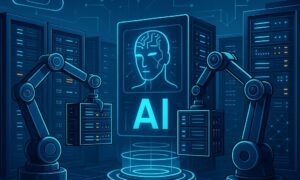Artificial intelligence (AI) software has rapidly evolved over the past few decades, but its origins date back to the mid-20th century. Early AI programs were developed in the 1950s and 1960s, focusing on tasks like problem-solving and game-playing.
However, it wasn’t until the 21st century that AI technology significantly impacted everyday life. Today, AI software is used in a wide range of applications, from speech and natural language processing to image and facial recognition.
One example of AI software is the random word generator, which uses algorithms to generate words based on certain criteria. The potential benefits of AI software are vast, including increased efficiency and productivity, improved decision-making, and more personalized experiences.
Here, we’ll examine some of the current trends and the opportunities and innovations that are on the horizon in AI software.
Trends within the World of AI Software
One major trend in AI software is the increasing use of machine learning algorithms designed to learn and improve over time. This has led to significant advancements in natural language processing and image recognition, among other applications. Machine learning also develops predictive analytics, allowing businesses to make more informed decisions and optimize their operations.
Automation is another big trend. Businesses use AI-powered systems to automate tasks and improve efficiency, from chatbots and virtual assistants to autonomous vehicles and robotic process automation (RPA). This can free human workers to focus on more complex tasks requiring a human touch.
AI is also being used to develop personalized experiences, from tailored marketing campaigns to personalized recommendations in e-commerce. By analyzing consumer behavior and preferences data, AI algorithms can predict what a given consumer is likely to want or need.
Excitedly, there is also a trend towards explainable AI, where the reasoning behind an AI decision can be clearly understood and explained. This is important for applications like finance and healthcare, where the stakes are high and transparency is critical.
A Look at the Future Opportunities in AI Software
The future opportunities of AI software are exciting — and seemingly endless. One major area of opportunity is in healthcare, where AI can improve patient outcomes and make healthcare more efficient.
For example, AI-powered diagnosis systems can help doctors make more accurate diagnoses and treatment recommendations, while machine learning algorithms can help predict and prevent diseases. AI can automate specific healthcare tasks, such as filling prescriptions and scheduling appointments, freeing healthcare workers to focus on more complex tasks.
Another area of opportunity is in the field of autonomous vehicles. Self-driving cars are already in development, and with further advancements in AI technology, they could become a mainstream mode of transportation. This could significantly impact traffic congestion, transportation accessibility, and urban planning.
Surprisingly, AI also has the potential to revolutionize education with personalized learning systems that can adapt to each student’s individual needs and abilities. This could help improve educational outcomes and reduce the achievement gap.
AI can be used to improve sustainability and address climate change. For example, machine learning algorithms can help optimize energy use and reduce waste, while AI-powered sensors can help monitor and predict natural disasters.
Innovations on the Horizon
When it comes to the future, there are several exciting innovations in AI software on the horizon. These have the potential to greatly impact several industries, including sectors within the private and public realms. One innovation area is the development of generative AI, which can create new content like images, videos, and even music. This has the potential to revolutionize creative industries like advertising and entertainment.
Another exciting innovation area is the development of edge AI, where AI processing is done closer to the source of data instead of being sent to a central server. This allows for faster and more efficient data processing and can be particularly useful for IoT devices and real-time applications.
There is also significant potential in developing AI-powered augmented reality (AR) and virtual reality (VR) applications. These technologies have already begun to transform industries like gaming and entertainment, but they also have potential applications in areas like education, training, and even mental health.
Quantum computing is an emerging technology that has the potential to greatly improve the speed and efficiency of AI processing. While still in its early stages, the development of quantum computing could significantly advance the capabilities of AI and open up new possibilities for its use.
An Exciting Future Ahead
Artificial intelligence (AI) software has seen incredible advancements in recent years, and its impact on industries ranging from healthcare to finance to education is set to continue growing. So buckle up, the future looks bright!

































